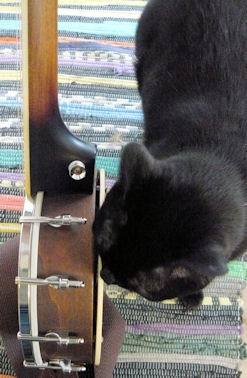
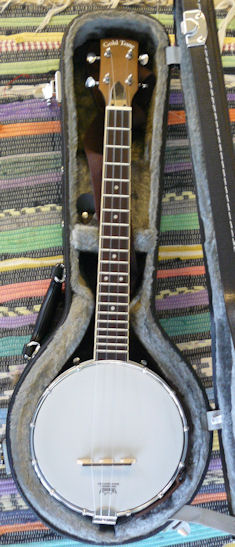
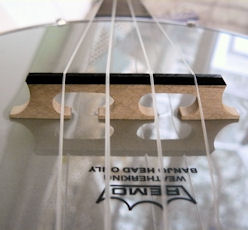
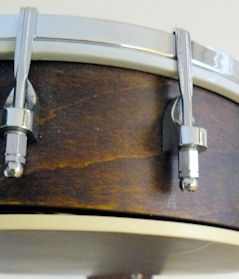
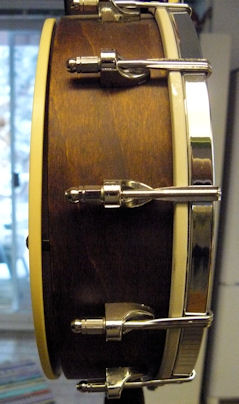
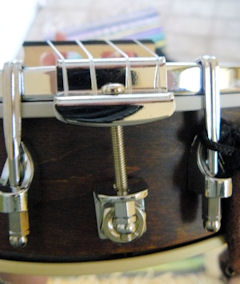
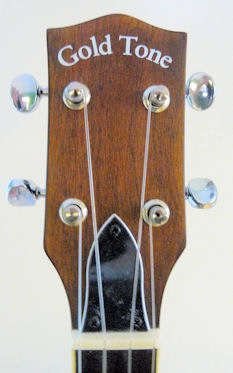

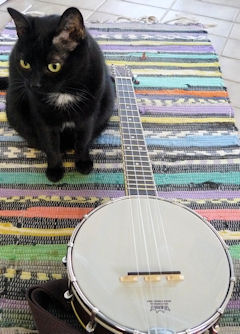
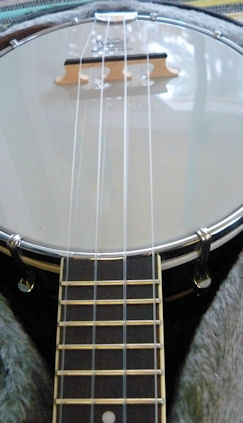
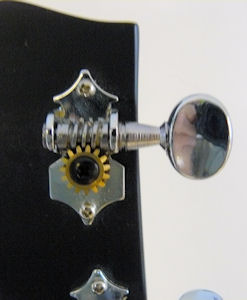
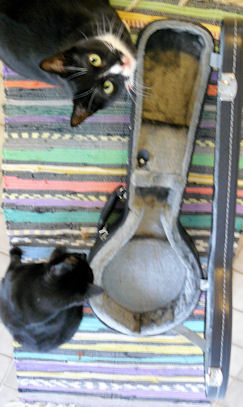
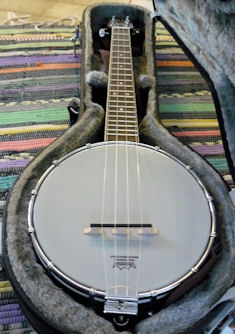
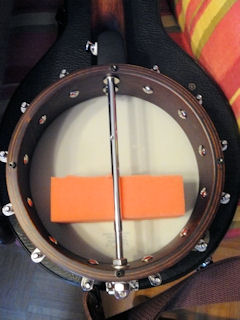
Gold Tone banjo ukulele
My first experience with a banjo ukulele (Waverly Street) was a mixed one, a sort of love-hate relationship. Mine was Dave G's first (and possibly only) tenor banjo uke. He makes nice, reasonably priced, no-frills instruments, mostly soprano and concert scale. I can't knock the quality.
I found the tenor simply too brash. Not the fault of the workmanship: rather the extra tension on the tenor strings probably makes it a less suitable scale than the shorter scales where string tensions make the tone less strident. It also had a small 7" head. A larger head would produce a bit lower range of tone, so an 8" would probably have been better. I could have loosened the head a bit, but it didn't occur to me until too late.
I sold the BU, but still wanted to get one. I was reluctant to go to a shorter scale simply because I prefer longer scales for my style of playing. In early spring, 2011, I heard that Gold Tone was making a baritone banjolele. As I had been playing more and more baritone uke, I was immediately intrigued. Before this, I had never heard of a baritone BU. Even tenors were rare (I can't find any historical reference to either tenor or baritone BUs being made by anyone but individual builders before 2010). And Gold Tone was reasonably priced ($339 retail).
I headed to Twelfth Fret in Toronto in mid-April, the closest Gold Tone dealer and the store most likely to have baritone scale in stock. I also got to play the other scales, so I could make my own comparison. Plus I got to play a few other ukes they had on display (the $1,850 new Martin soprano seemed overpriced by at least $1,700, but an older Martin soprano was a steal at $500...)
Gold Tone makes three different lines of BU. The top of the line is the DLX (deluxe) model, which seems to be made only in soprano scale, and the regular model, which is a somewhat stripped-down version of the DLX, again in soprano only. Then there are the four "basic" models - soprano, concert, tenor and baritone (indicated by their BU prefix - BUS, BUC, BUT and BUB).
All have an 8" head. This is a Remo mylar (synthetic) head. Remo also makes drum heads, and offers some variant skin materials if you're inclined to change the plastic for natural or another synthetic to try for a different sound. Most standard banjos have 11 or 12-inch heads, so I wonder if a slightly larger head might have suited the baritone better. The size might have been dictated as much by availability of banjo head sizes but 10-inch heads are available (Beansprout uses one). That would have required different engineering of the resonator for this model alone, and probably greater cost.
The BUS and BUC have 18 frets, the BUT and BUB have 20. I find that above the 15th fret, the sound is tinny and shrill. Might be some fret buzz from the low action I can hear, too. Intonation is excellent through the first 12 frets. At the 15th, mine seems a hair flat, which may be easily fixed by a micro-shift of the bridge. But I don't play up there a lot, so it's not really an issue for me.
All models use open, chrome-plated geared tuners, Grover-style, and have a plate-style resonator over the back. I might upgrade the tuners to a better brand since there have been online comments about slipping strings on various sites.
All have typical maple bridges with narrow ebony saddles. My first thought was to look at alternate bridge/saddle options. While the maple/ebony seems traditional, there are bone, ivory and graphite options that will change the tone. I might even try gluing a Tusq saddle to a wood base. If you change your bridge, mark the location of the existing one on the head first, so you have a reasonably close position to place any subsequent bridge. The nut is bone.
The BUB came strung as high-D, rather unusual for any baritone. The technician, Grant, asked me if I wanted it replaced with a low-D, but I actually prefer the high-D because it sounds more ukulele-like. Also, a low-D string would likely be wound, which would have a more noticeable sound when sliding fingers on it.
The neck is smooth and has a nice thickness. Nut width is 1 3/8" (seems to be the same on all models). There is a truss rod ("coordinator rod") in the neck, too, another rarity among ukes and banjo ukes (although the long neck would seem to justify it here). There is a nice cream-coloured binding along the neck.
The head is held securely in place by 12 chrome-plated J-bolt hooks. A small chrome-plated tool is provided to both tighten/loosen the hex nuts on the hooks, as well as tighten/loosen the screws holding the resonator plate in place.
There's a chrome-plated "EZ string tailpiece" which is a simple bracket with holes (I'm unsure who "Ez" refers to, possibly a designer or engineer named Ezra? Ezekiel?). It doesn't appear the metal of the tailpiece is cutting into the strings, so it seems to have been adequately de-burred, but it will have to be watched (the string holes are very small and will not permit a sleeve over the string end to help protect them - this might be problematic). It's supposed to be a "no-knot" tailpiece but the strings definitely have knots in them. Not sure how else they can be held in place.
The BU line also comes with a snug hard-shell case. The case is well thought-out as a musician's case, not just protection. It has metal 'feet' on the bottom and back to protect it when on the ground, and the hinges have a bulbous extension to protect them when the case is placed on that side. Gold Tone obviously pays attention to how cases are placed and stored. There's a lined pocket inside for a tuner and the included tool, and a strap can (barely) be fit into the case, but not much else. The fit is tight, though, and I am concerned the top presses a little too much onto the bridge when closed.
Gold Tone is made in China, but has a good reputation for quality at a reasonable price. On all of the models I played, I found the fret edges smooth, the action good and quite low. The fretboard is rosewood, the neck and resonator a dark-stained maple. Overall there are no rough edges or unfinished bits and it looks pretty sharp.
The resonator plate on the newest models have eight screws holding them in place, but the older ones only have four. The plate has a noticeable warp on the four-screw models, but this is merely cosmetic and doesn't affect the sound. It can be rectified by adding additional screws between the supplied ones. I had initially thought the resonator plate would 'warm' the sound by giving it wood to reflect against. I'm not sure that's true any more, and will have to experiment with different materials inside.
You can also remove the resonator plate for a somewhat lower volume sound. Keep in mind that banjoleles were designed to be loud so they could be heard on stage in an era when electrical amplification was either not used or new and imperfect. At home this volume might be a bit overpowering. The resonator plate directs the sound forward, so removing it will prevent that.
With a tight head, a BU is very, very sensitive to every touch, scrape and tap of the strings. This is both good and bad: it can amplify every touch, even mistakes. But it can also be used to great effect for some subtle playing. I can sit at night and gently stroke the strings and hear the sound clearly, while upstairs Susan sleeps undisturbed. I might loosen the head a little to see how that affects the tone and volume, but too much might create some fret buzz, too, as the bridge lowers.
A BU player on the Ukulele Underground also recommended removing the resonator for home play, and even putting a sponge (the inexpensive synthetic kind) or piece thereof between the head and the support strut inside to mute the sound. I've read about banjo players putting cloth inside to muffle it, too. Alternatively, there are numerous banjo mutes available that attach to the bridge, ranging from a few dollars to $25 or so. I'll experiment later.
The first (E) string was a tad too close to the fretboard edge when I first tried it, and I found my playing often rolled the string right off the edge. Grant at Twelfth Fret quickly set it up so the string was further in and after that, it played nicely. If I ever change the bridge, I would have to keep this in mind when cutting notches for the strings.
There are inlaid fret markers at the 5th, 7th, 10th, 12th and 15th frets, side and top, but not the 3rd. I still argue that a third-fret marker should be provided on ukes, but they are rare.
The BUB is heavy. All that metal makes this BU heavier than any standard ukulele and even heavier than my Waverly Street BU. It definitely calls for a strap if you plan to play standing up. Grant installed a strap button just under the heel, then tied the other end onto one of the J-bolts, and attached an inexpensive guitar strap. A mandolin strap might work, but it's very narrow. I'd prefer to see one of Lori's Uke Leashes designed for the extra weight of the BU. However, attaching a strap of any sort requires a little thought (you can tie ends onto the J-bolts, or the head, or attach a strap button as I did).
Sound is as expected: loud, brash, bright. Not as crisp and ringing as a metal-stringed banjo, but definitely a banjo sound. It makes any uke sound mellow in comparison. And that means not all songs are suited for it. Working through my songbook, I've found a lot of music that suits the sound, but others that just don't. I play many songs from the 20s and 30s that work, both fingerpicking and strumming (I currently lack the ability to play Formby's complex split-triplet strumming but I shall practice assiduously).
I'm not sure what strings came with the BUB, but I don't believe they're Aquila or any other string I recognize. They're unwound, lightly translucent and smooth. Almost like D'Addario, or Worth. Whatever they are, they seem a good choice for the sound.
The sound also lends itself to jamming with other instruments where it can complement the others, although care has to be taken to avoid overwhelming other ukes with the sheer exuberance and volume of the BU.
I played the other BU models at the store and my personal experience based on that brief time is that the soprano and concert have the best sounds if you're looking to replicate the sounds of the 1920s and 30s and the strings have a nicer feel to them. The tenor seemed a little brasher than I would like for that sound (as I found with the Waverly Street), But the baritone is a nice sound, too, comparable to the concert but at a lower pitch and the strings not too tense.
Nylon-stringed banjo ukes have a tonal similarity with nylon-stringed resonator ukes. They lack the ringing, sharp tones of steel strings. But they have the advantage of being a slightly warmer sound and a little easier on the fingers. It is banjo-ish, but not entirely like one.
I've considered experimenting with placing a metal plate and a non-reflective cover over the resonator to test the resulting sounds from each. That will come in future, along with some bridge and string experiments.
Overall, I'm very pleased with the Gold Tone baritone banjo ukulele. Quality is good, especially for the price. It plays well, with good action and intonation. Sound is good, and clean - although it may take some time to adjust my playing to its nuances. I think it would sound even better with a 10" head, though. It makes me want to look more seriously at the concert scale, too.
I have to toss in a free plug for Twelfth Fret in Toronto (Danforth at Woodbine). I love the place. They have hundreds of instruments to try, from new to vintage, separate rooms to play and tinker, and some of the most knowledgeable sales people - all of whom seem under no pressure to push a sale. And the technician who I dealt with - Grant - was a great guy to talk with, while he set up the BU, and installed a strap button, all at no extra cost. I almost bought a short-scale vintage Kay bass as well, but thought Susan would have skinned me alive (and would have bought a National resonator uke had it been available in tenor scale). Plan to spend at least an hour in the store, but put the money in the parking meter for two, just in case.
Update: There are some simple options available to alter the sound and volume. Removing the back is easy and immediately lowers the volume. Putting a small piece of synthetic sponge inside, wedged against the skin, also dampens it considerably and softens the tone. It can also sound a little thin and dead if the piece is too large. A pie plate or metal plate as a reflector gives it a metallic ring bit like a resonator uke, but a trifle too bright so far. More experimentation is needed. Will get some felt and cork today to play with.
Would I purchase another Gold Tone uke? Yes.
Would I recommend them to others? Yes.
Rating (0-5): ****
Status: new and playing.
